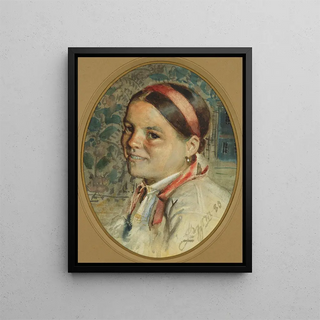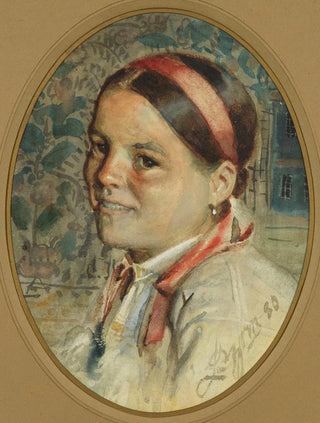Art print | Woman's head - Anders Zorn


View from behind

Frame (optional)
The "Head of a Woman" by Anders Zorn is a piece that instantly captivates the eye and the mind. This painting, imbued with sensuality and delicacy, transports us to a universe where feminine beauty is celebrated with rare intensity. Zorn, a master of portraiture, succeeds in capturing not only the physical features of his model but also an essence, a personality that transcends mere visual representation. By contemplating this work, one is invited to explore the subtleties of human emotions, to feel the depth of a gaze, to live the moment of a frozen encounter in time. The "Head of a Woman" is much more than a simple depiction; it is a reflection on the human condition, an ode to femininity.
Style and uniqueness of the work
Zorn's style is distinguished by an exceptional mastery of light and color. In the "Head of a Woman," delicate nuances of skin, subtly placed shadows, and light flashes that caress the face testify to refined technique. The artist uses a palette of soft, almost pastel colors, which gives the piece an intimate and warm atmosphere. The composition, meanwhile, is both simple and powerful. The face, slightly tilted, seems to come alive with its own vitality, while the blurred background highlights the central figure. This stylistic choice enhances the sense of proximity and intimacy, allowing the viewer to feel connected to the work. Zorn manages to fuse realism and impressionism, offering a unique vision that both challenges and moves.
The artist and his influence
Anders Zorn, born in 1860 in Sweden, is one of the most influential artists of his time. His career, marked by travels across Europe and the United States, allowed him to immerse himself in various artistic cultures. Zorn successfully combined tradition and modernity, integrating elements from the great masters while developing a personal style. His approach to portraiture, blending realism and sensitivity, has inspired many artists, and his influence is still felt today. Zorn was also a passionate advocate of the

Matte finish

View from behind

Frame (optional)
The "Head of a Woman" by Anders Zorn is a piece that instantly captivates the eye and the mind. This painting, imbued with sensuality and delicacy, transports us to a universe where feminine beauty is celebrated with rare intensity. Zorn, a master of portraiture, succeeds in capturing not only the physical features of his model but also an essence, a personality that transcends mere visual representation. By contemplating this work, one is invited to explore the subtleties of human emotions, to feel the depth of a gaze, to live the moment of a frozen encounter in time. The "Head of a Woman" is much more than a simple depiction; it is a reflection on the human condition, an ode to femininity.
Style and uniqueness of the work
Zorn's style is distinguished by an exceptional mastery of light and color. In the "Head of a Woman," delicate nuances of skin, subtly placed shadows, and light flashes that caress the face testify to refined technique. The artist uses a palette of soft, almost pastel colors, which gives the piece an intimate and warm atmosphere. The composition, meanwhile, is both simple and powerful. The face, slightly tilted, seems to come alive with its own vitality, while the blurred background highlights the central figure. This stylistic choice enhances the sense of proximity and intimacy, allowing the viewer to feel connected to the work. Zorn manages to fuse realism and impressionism, offering a unique vision that both challenges and moves.
The artist and his influence
Anders Zorn, born in 1860 in Sweden, is one of the most influential artists of his time. His career, marked by travels across Europe and the United States, allowed him to immerse himself in various artistic cultures. Zorn successfully combined tradition and modernity, integrating elements from the great masters while developing a personal style. His approach to portraiture, blending realism and sensitivity, has inspired many artists, and his influence is still felt today. Zorn was also a passionate advocate of the






